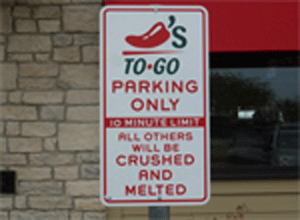
If you’ve dined at a Chili’s restaurant, you might have noticed the sign above the space reserved for take-out parking—To Go Parking Only | 10 Minute Limit | All Others Will Be Crushed and Melted. Do we believe that? Of course not, but we get the message much better than if they had stated the precise truth—If we happen to notice your car has been there a long time, we might put a note on your windshield, asking you to please park somewhere else.
The message on the sign is what we call “hyperbole,” which is an obvious and intentional exaggeration. Its goal is not to deceive, but to create a picture and communicate a message that is better than the bland but perfect reality.
This is different from a car salesman’s stretching the truth, a con artist’s misapplication of the truth, or a fisherman’s embellishment of his “unbelievable” truth. People are smart. They catch on quickly, and as soon as they do, the whole message has little value.
No matter how true our stories are, they must be believable. Overstatement can be a wonderful tool for humor to emphasize a point, as long as the claim is clearly an absurdity and is not a cliché.
Naked Truth: Mom had cooked more for dinner than I could eat.
Cliché: Mom had cooked enough dinner to feed an army.
Better Detail: Mom had cooked enough dinner for our family and the neighbors, but I was the only one at the table.
Hyperbole: Mom had cooked enough dinner to supply the downtown mission for a month.
Here are some effective advertising overstatements:
- Disneyland — The happiest place on Earth.
- Exxon — Put a tiger in your tank.
- Sherwin Williams — Cover the earth.
- Kay Jewelers — Every kiss begins with Kay.
- Energizer — Keeps going and going and going.
- Geico — So easy a caveman can do it.
- Ajax — Stronger than dirt.



